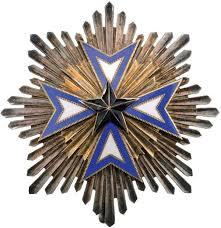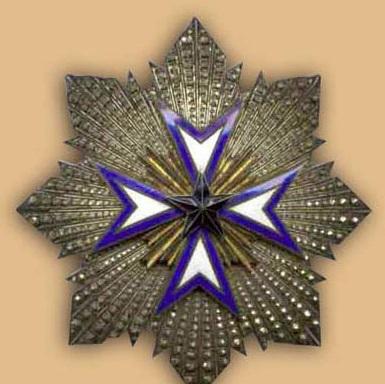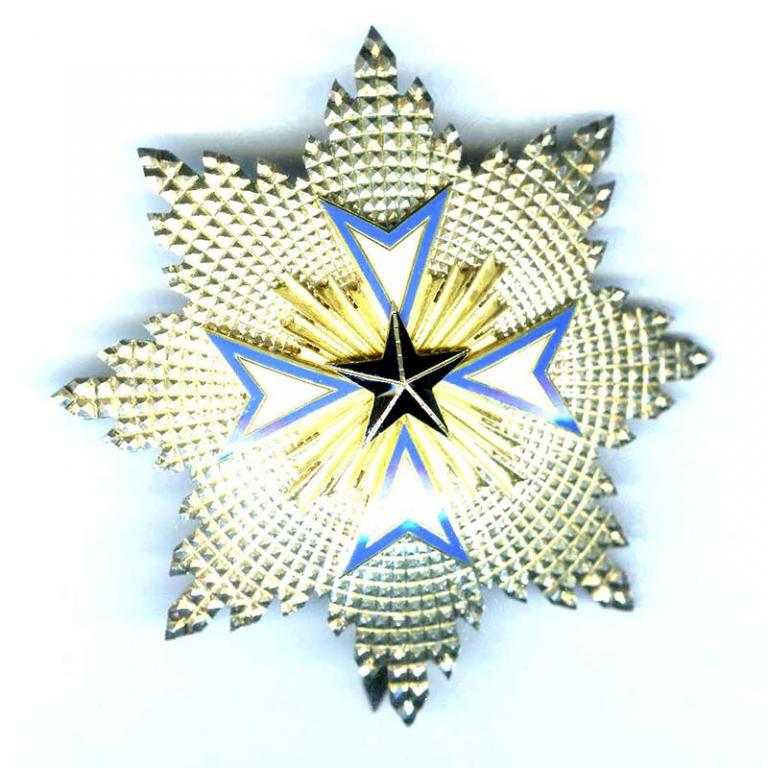
922F
-
Posts
1,380 -
Joined
-
Last visited
-
Days Won
7
Content Type
Profiles
Forums
Blogs
Gallery
Events
Store
Posts posted by 922F
-
-
Point of my post above being that persons associated with so-called 'self-styled' awards wore the type of cross pictured in post one above. Presumably, birds of a feather stick together. Or, if you prefer, this item may well be ‘awarded’ by a ‘self-styled’ knightly or chivalric organization.
Eagle iconography not linked with ‘main stream’ St. Lazarus or San Luigi or Lippe insignia either.
0 -
Persons associated with the late Prince Ernst August of Lippe's Society of the Rose, the San Luigi Orders, the Order of St. Lazarus in the U.S.A., the Royal Yugoslav Order of St. John, and comparable organizations wore similar crosses in the 1970's-80's. I do not recall the exact format--the eagle may have had two heads then? Do not recall the name of the troupe that used this particular cross or post-2000 images of individuals wearing it. Photos appearing in publications issued by the above named entities and the Augustan Society [do not have at hand now] illustrate this item and an analogous neck cross as worn at comradely events. This perhaps suggests that the insignia represents membership in a 'private' society. Some such groups choose Insignia quite similar to state decorations...
0 -
The Belgian Foreign Ministry publishes annual [sometimes biannual or quarterly] lists of consuls and diplomats accredited to the Kingdom. I am not sure when this practice began but saw an 1835 or '36 copy at the Albertine/Albertina [National Library] in the early 1990's. The Foreign Ministry probably would be another likely research prospect. Good luck!
0 -
Thank you, Owain, for this gift! The photos reveal Fahmy's true essence and spirit. Unfortunately, I did not memcon my personal interactions with this wonderful man and now have only faulty 30-40 year old memories. Fortunately, I certainly do recall Fahmy's hospitality, kindness, and warm personality.
1 -
Jan, that's a quite hard to find medal. You have done well! I believe that a northern Italian State used this same ribbon for a mid-late 1890's 'in exile' Rothe-made award.
So as to the ribbon, I agree with SR's opinion. It may be possible, however, to misconstrue SR's mention of the India Cruise medal to suggest that the Empress Elizabeth sailed on the ship. The Seereisedenkmünze commemorated participation or service connected with the 1892-3 ten-month voyage to the Far East performed by SMS Kaiserin Elisabeth. Archduke Franz accompanied the vessel on this 'showing the flag' venture. Emperor Franz Joseph I of Austria-Hungary approved that medal on November 11, 1893.
0 -
Snowpie, What a rare and wonderful award. Thank you for displaying this precious item! And, yes, the Magician, Bata, is a great person and phenomenal, astounding pool wizard. Seeing him in action delights and mystifies anyone fortunate enough to observe!!
1 -
Most emotive presentation honoring a gallant individual. 8055 MASH [Mobile Army Surgical Hospital] was a U.S. unit thus explaining DD Form 511 for non-U.S. citizens as indicated by Report of Interment overstamps.
0 -
Terrific! Have been looking for this badge as a single for years...anyone with a spare please contact me.
0 -
If gold or silver gilt, metal fineness marks would appear, usually on large wreath ribbon ties at bottom of badge or on badge suspension lug or ribbon ring. Same locations for maker marks.
Lack of marks & wear to badge suggests bronze-gilt example to me.
0 -
If Vietnamese, AKA Gold Star Medal type 1-- see GMIC topic Socialist Republic of Vietnam - Gold Star Order.
Might be Bulgarian Hero of Peoples Republic, as star looks broad.
In either case, suspension ribbon pin shape looks like a truncated isosceles form rather than rectangular.
0 -
1812--Paul's observation aside....
German, French, Austrian, Greek and other nations' manufacturers produced such insignia. If you can find a copy of Tazedakis, Panos N.: The Order of the Redeemer Anatomy and pathology of the insignia of the Greek Order of the Redeemer. Athens 1994. ISBN 9608552214, you may discover this star's maker [if there're no other identification markings]. I do not have access to this valuable work, having lent mine years ago to someone who never returned it!
Since the Redeemer is almost always hand-painted, many variations exist, even among those produced in the same time period by the same jeweler. A good number of original pair Grand Cross and Grand Commander set badges & stars have inconsistent Redeemer portraits. Major differences besides the 'blessing hand' finger position/proportions include hair color, halo configuration and included symbols, beard shape, robe trim, and number of lines depicted on the book pages. Tazedakis attributed these variances to artistic license, if I recall correctly.
0 -
-
Sincere thanks to you Emmanuel for this most useful information.
0 -
There were [are] a number of "Imperial Brazilian" memorial organizations that have insignia. Some incorporated a Pedro I type monogram into their badges...the crown form on your items does not resemble the typical Brazilian imperial crown closely however. If there was a Randel Rio mark, or some other Brazil connection, would tend to go with one of those groups.
0 -
Yes, as named on the Belgian Society diploma << Société UNION et MAINTIEN>>. The Belgian group also used the name La Société de Secours Mutuels « Union et Maintien ». The société royale UNION et Maintien, another Belgian group probably is a completely different organization. Offhand I don't find web info or either the French or Belgian groups. May have a French type diploma somewhere though.
1 -
OvBacon addressed most of your queries.
Your question #3 This is an award of a private society, not a nation's award.
Your question #4 The 5 grades in this award recognize degrees of contributions either money or services to the Societe. Formerly a website publicized the group--cannot locate it now.
Your question #5 Looks like a 1960-80 made item. If enamel is soft type, maybe mid-late 1980's-90's or early 2000's. If it were uniface, it would be current production.
Your questions #6 & 7 Neck badges and below appear on French eBay fairly often. You rarely may find a few higher classes there as well. Prices [including taxes & delivery] realized on French eBay are a fairly accurate value guide.
1 -
Any marks on reverse?
0 -
Looks like perfectly original pre-1960 Karnet Kysely, Prague, manufacture piece. Examine for silver hallmark (900) and maker`s mark "KK", maybe on ribbon loop connecting ring; I see something there but can't make it out. Value in eye of beholder; in 2017 a similar example sold at auction for 1700 euro plus commission & delivery see https://www.livebid.cz/auction/katz_10ea/search/order. A damaged one sold there for about 1/2. One sold at la Galerie Numismatique several years ago for somewhat more plus commission & delivery.
0 -
Having personal knowledge and dealings of/with each and every individual named in Bill Stump's comments including Bill himself, I certainly verify that there's definite truth in his assessment regarding Ernst and the general fraud scheme scene 'back in the day'. It's obviously possible that similar conditions apply today, so educate yourself and remain aware.
As Eric suggests, Bill's remarks demonstrate strong bias and ad hominem argument against individuals with whom he disagreed or wished to denigrate. The article contains at least two completely misleading discussions regarding individuals [not the main players] whom he disliked that cumulate in factual error. I attempted to contact Bill regarding his incendiary comments when I first became aware of them but he never responded.
Especially disturbing to me was the fact that many of the people he published inflammatory gossip concerning or imputed motives in passing to were dead when his material appeared in public purview. Bill clearly got it right on several of them. On others he was completely wrong--those who knew them from their work were simply astounded. Some living persons he scorned in his piece told me in essence 'what do you expect from Bill'. Others simply refused to be drawn into argument.
My point in writing this? Consumers usually don't know or are hard put to discover author's biases. Mixing fact with opinion, truth and rumor results in distorting or obscuring the message when the full story emerges. Ask many politicians, the full story generally emerges!
0 -
PM sent.
Images of three different variety star bodies follow below. Indications are #1 below was first type [1889] but within a year or two [1891-2?] #2 appeared [Kretly examples known]. Some say that degraded versions [less detail and badges not configured as closely to star body] of both continued through the 1930's but that #2 style ended after 1945-'46. Other believe that #2 may have persisted through the 1950's. Other variants known include the so-called Portuguese type that follows a #2 pattern and a Spanish type as 3rd image below. The Museum of the Legion of Honor in Paris displayed a star with nearly Austrian type faceted rays supposedly with connection to famed French General Dodds some years ago.
0 -
The first one looks to be Bertrand or associated firms, work. The reverse pin may have a Bertrand mark and a silver fineness mark. Some star pins or bodies are marked 'Bronze'; such are of course silvered bronze. If it is silver and the enamel cross is very well contoured to the star body [so that the enamel appears to 'bend'] maybe 1910-40's. If cross not well contoured [with flatter or flat enamel], '30's-'60's.
The second type star usually appears with a silver body and silver or more often bronze gilt badge not well configured to the star body. Some of these have Da Costa of Lisbon maker plate at the reverse centers. To my knowledge, definite dates have not been determined for Da Costa pieces though they have been attributed to the 1940's-'50's.
Discussion over the shade of blue enamel as an indicator of period used to occupy Black Star of Benin enthusiasts with the darker shade being generally accepted as being older.
A better indication of period is the badge suspension wreath with more detailed and better enameled ones being obviously older. And even with badge present unless workmanship and exact enamel shades closely match appears no definite way to know if they are an original set. Here we have no badge image to assist anyway.
0 -
A number [at least 4] genuine Schwerdtner backplate roundels were sold on French eBay in the past 2 years. They were from French manufacturer Delande's old stock. Perhaps the faker bought them? I agree with Peter's opinion regarding the pin hinge attachment and sloppy detail work.
0 -
First time to see this!! The Military Museum in Sofia did not have one of these [cased] in 1980 & probably not even now. Never saw this degree cased in any private collection!! Thank you for posting!!
0 -
Although legislation dated 1930 describing/creating a Decoration for Arts and Sciences exists, seems like it was never realized. Reliable authorities including Lame, Rrumbullaku and Swire all mention it and a similarly ephemeral 1936 medal for exceptional service in the Gendarmerie.
Some 30-35 years ago, a now defunct auction house offered a 'royal Albanian Decoration for Arts and Sciences' on a green ribbon [correct ribbon according to Swire]. It actually turned out to be a shaved 1930's 5 lek coin with a hole drilled at the top for ribbon rings!
0





Order of the Holy Sepulchre
in Southern European & Balkan States
Posted · Edited by 922F
add info
Agree with Sal & Graf, as usual! Grand Cross badge should measure in the 55-59 mm by 105-115 mm range. Workmanship/appearance of this example suggests Stange, St. Louis, Mo, U.S.A. origin [thick, non-tapered or striated 'loop' for ribbon [cravat] attachment, very thin connecting rings between cross and trophy of arms, plus trophy of arms rather 'flat' appearance]. Would guess 2000's manufacture. Similar neck badges offered at about US$200 sometimes including case & ribbon on e*ay.